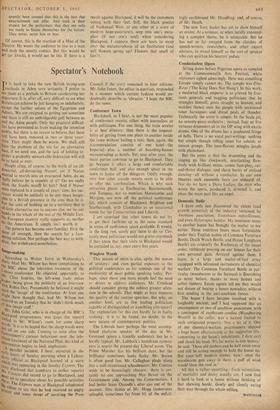Domestic Strife I haVe only just discovered the extent (and
growth potential) of the industry sustained by Anobiion punctatum. Xestobium rufovillosum, and even Hylotrupes bajalus. My imminent move to another hquse has brought the matter to my notice. These creatures (even more formidable under their English names of Common Furniture Beetle, Death Watch Beetle, and House Longhorn Beetle) are evidently the Rachmans of the insect order, ruthlessly preying on our houses for their own personal gain. Arrayed against them, I learn, is a large and matter-of-fact army equipped with advanced instruments of chemical warfare. The Common Furniture Beetle in par- ticular (woodworm to the layman) is flourishing as never before, thanks to more houses and softer timbers. Estate agents tell me they would not dream of buying a house nowadays without first sending in the anti-anobium forces.
The house I have become involved with is laughably ancient, and I had supposed that an encampment or two of anobium punctatum, with a contingent of euphryum confine (Woodboring Weevil) in the cellar, was a hazard limited to such antiquated property. Not a bit of it. One of my chemical-warfare practitioners slapped a huge beam affectionately at the suggestion (dis- concerting to the beam's inhabitants. I dare say) and shook his head. 'It's far worse iu new houses,' he said. 'These old timbers can be half eaten away and still be strong enough to hold the house up. But your soft modern timber, now: once the woodworm gets away in there, a puff of wind would blow the roof in.'
All this is rather unsettling: fresh intimations of mortality and decay usually are. I now find it hard to look at a house without thinking of that chewing horde, slowly and silently eating their way through the whole edifice.
WATCHMAN






































 Previous page
Previous page